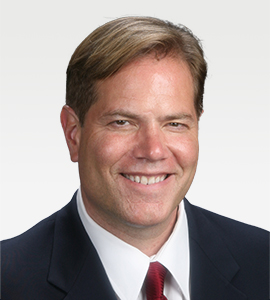Congratulations to Dr. Scott Zeller, whose pioneering work in psychiatric emergency care was praised by experts in a recent NPR feature. In this article, he discusses the emergence of the Alameda Model and how hospitals can put this innovative approach into practice.
The Burke Center Mental Health Emergency Center in the remote Texas town of Lufkin is the world's first outpatient psychiatric emergency service with zero psychiatrists on staff. Instead, care is supervised by telepsychiatrists and delivered onsite by a multidisciplinary team of counselors and nurses. The center offers a comprehensive range of services, including an extended observation unit, a crisis residential unit, and a mobile crisis response team.
Since implementing this delivery model, the results have been striking. State hospital bed utilization in the 12 participating counties has decreased by 32 percent. Patients have been overwhelmingly satisfied with the care provided. In 2011, the Burke Center was honored with an American Psychiatric Association Gold Award for innovation and achievement.
A Paradigm Shift
The experiences of the Burke Center and similar programs across the country suggest that acute psychiatric crises can often be resolved in the outpatient setting. Yet at EDs nationwide, patients wait an average of 8 to 34 hours for an inpatient bed at a behavioral health facility.
The practice of boarding psychiatric patients in the ED contributes to crowding, which decreases all patients' safety and satisfaction. In EDs without adequate psychiatric coverage, these patients may receive little immediate treatment, and the noisy, chaotic environment may exacerbate their fear and agitation.
So why do we continue boarding these vulnerable patients? One reason is the assumption that most people in psychiatric crisis need inpatient care. Patients presenting to the ED with a psychiatric condition are 2.5 times more likely to be admitted than those with only a medical diagnosis.
Another factor is that many behavioral health patients arrive in the ED under an involuntary hold, meaning a designated professional has judged them to be dangerous or gravely disabled. Some jurisdictions allow emergency physicians to lift involuntary holds, but even in these locations, there are substantial liability risks associated with this practice that undercut the reasoning behind the hold — namely, to get the patient a comprehensive psychiatric evaluation. Where there is no reasonable process for lifting holds, hospitals may have no choice but to admit all involuntary patients for disposition. (This would be analogous to admitting all chest pain patients rather than the 10 percent who actually need inpatient care.)
In my experience, this emphasis on inpatient care is misguided for several reasons:
- With proper care, many psychiatric emergencies resolve within 24 hours, allowing patients to safely continue treatment in the community.
- Surveys show that both ED directors and consumers strongly support the development of specialized psychiatric emergency services.
- The number of inpatient psychiatric beds has been shrinking steadily since the 1950s, and there's no indication that this trend will reverse in the future.
Hospitals and communities should therefore consider investing in alternative treatment designs that emphasize prompt intervention and stabilization in the outpatient setting.
The Alameda Model
For more than 19 years, I served as Chief of Psychiatric Emergency Services at John George Psychiatric Hospital, a stand-alone behavioral health facility within the Alameda Health System. We developed a regional model for psychiatric emergency care that has become a blueprint for programs around the country. We called it the Alameda Model.
This psychiatric emergency service (PES) is an EMTALA-compliant, psychiatric-patient-only ED, which works with 11 area medical EDs to provide intensive treatment with the goal of rapid stabilization. The department is staffed around the clock by psychiatrists and nurses and serves all medically stable patients regardless of ability to pay. Services are provided on an outpatient basis. Maximum length of stay in the PES is 24 hours, which is fully covered under the "crisis stabilization" provision of California's Medicaid program.
The PES approach has many benefits. About 75 percent of patients are discharged within 24 hours, and this figure is common for PES programs around the nation. This demonstrates that even patients in crisis can be stabilized quickly in the less-restrictive outpatient setting. The PES model reduces the need for hospitalization, freeing up scarce inpatient beds for those who are truly in need.
Hospitals are also reaping the benefits. Psychiatric boarding at Alameda County EDs has all but disappeared. Once medically cleared, the average behavioral health patient waits less than two hours for transfer to the PES. Hospitals no longer need to provide around-the-clock psychiatric coverage and can often scale back their case management services.
Leading Change
So how can hospitals interested in redesigning emergency psychiatric care get started?
- Bring together all of the stakeholders, including providers, hospital administrators, and representatives from community mental health organizations. Let each participant share how they see the problem and what, in their opinion, needs to change.
- Start developing a consensus around next steps. Bear in mind that a PES is just one option. Others include telepsychiatry, developing a crisis stabilization unit, or advocating for policy change around involuntary holds. Individual EDs can often accomplish a great deal by creating more welcoming, therapeutic environments for patients.
- Emphasize the big picture as you work to gain buy-in. While change is never easy, innovative delivery models like the PES and telepsychiatry complement the goals of healthcare reform. All forms of healthcare delivery are currently shifting toward outpatient settings, and emergency psychiatry is no different. Our efforts will benefit not only our behavioral health patients but also the communities that rely on our EDs for lifesaving care.
2018 update: This article was originally published in 2015, when Dr. Zeller Chief of Psychiatric Emergency Services at the Alameda Health System. He has since joined Vituity as Vice President for Acute Psychiatry, where he leads the expansion of a robust psychiatric care practice line.
For more information about Vituity’s solutions for acute psychiatry, please visit https://www.vituity.com/healthcare-services/psychiatry.
Originally posted April 30, 2015. Last updated May 11, 2018.























